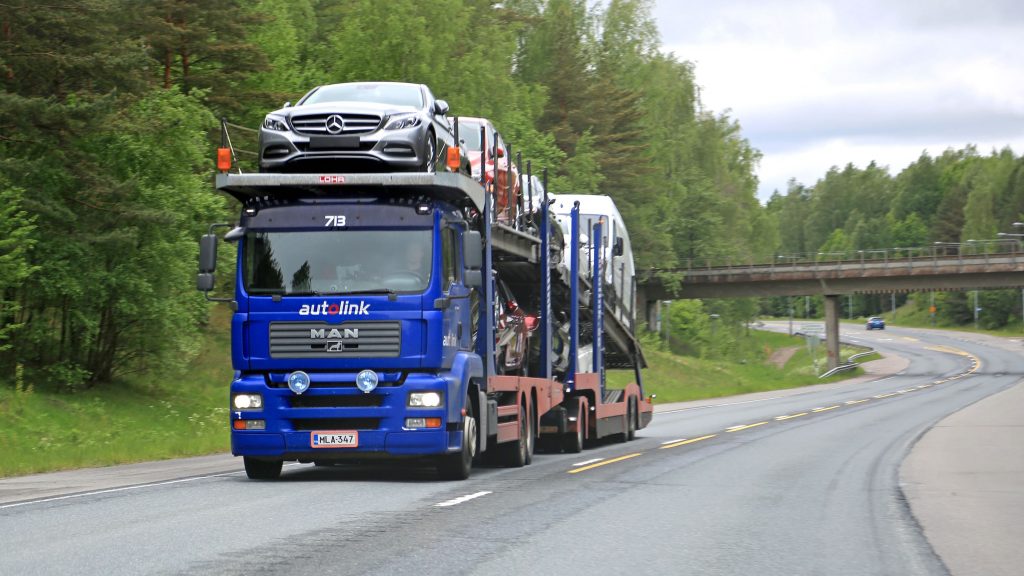 [sta_anchor id="1"]Electronic consignment notes were given the green light by the EU in 2011 but their implementation across European countries remains patchy. Has their time finally come… or gone?
[sta_anchor id="1"]Electronic consignment notes were given the green light by the EU in 2011 but their implementation across European countries remains patchy. Has their time finally come… or gone?
So far, only eight EU member states and Switzerland have ratified the so-called e-CMR protocol – the digital addition to the United National CMR Convention that was adopted in 2011 – and these do not include larger nations such as Germany and the UK (at least while it actually remains a member state). Hardly surprising, then, that electronic delivery notes remain largely absent from the European finished vehicle logistics sector.
The e-CMR protocol provides a legal framework allowing the use of electronic consignment notes for international transport. The protocol explains how to organise transport without a traditional printed document and sets out the legal requirements and rights in the case of court proceedings.
In theory, electronic consignment notes could one day replace today’s standard delivery notes and enable more efficient use of electronic proof of delivery (ePOD) and other IT solutions. In practice, however, that day looks a fair way off, giving the tardy approach by various member states. This, in turn, has had a knock-on effect on plans to extend this electronic protocol to other modes of transport such as shipping and rail.
Frustrated with the lack of progress, bodies such as the International Road Transport Union (IRU), the Association of European Vehicle Logistics (ECG), and individual truck carriers have urged governments to do more to encourage adoption of the protocol. But while such calls have reached sympathetic ears, including those of some Members of the European Parliament (MEPs), the EU Commission is limited in the power it can exert in this area.
In this story...
Nicolette van der Jagt, director general at the European Association for Forwarding, Transport, Logistics and Customs Services (CLECAT), agrees that wider use of e-CMR and the further digitalisation of transport documents more generally would lead to a more competitive transport system and decrease administrative costs.
“The problem with the e-CMR, which is definitely supported by our members – freight forwarders – is that there is legal uncertainty and a lack of uniform implementation of existing European and international legislation by member states,” she says. However, this is being discussed in the Digital Transport and Logistics Forum, established by the European Commission, of which CLECAT is a member.
In recognition of the obvious benefits of electronic systems, some European countries have already created their own national systems for electronic freight documents. High-profile examples include the Netherlands, which has established the TransFollow system – a platform that lets companies create, send and archive digital CMR-documents – and Denmark, which has established the ecmr.dk system.
Henning Nørgaard, a consultant at the Association for the Danish Road Transport of Goods (ITD), which runs the Danish system, believes the advantages are clear and he echoes calls for e-CMR systems to be adopted in all EU countries. “It will be easier to handle the document,” he states. “There is no wrinkled paper in the truck with a coffee stain on it. And everything will be faster. The sender can receive a message as soon as the goods are delivered and can then send the invoice. The authorities also have better opportunities to control the whole transport chain.
 "When an electronic e-CMR system is integrated with the sender’s and the transport company’s IT systems, then most of the work in creating the consignment note is automatic" - Henning Nørgaard, consultant at ITD
"When an electronic e-CMR system is integrated with the sender’s and the transport company’s IT systems, then most of the work in creating the consignment note is automatic" - Henning Nørgaard, consultant at ITD
“When an electronic e-CMR system is integrated with the sender’s and the transport company’s IT systems, then most of the work in creating the consignment note is automatic. And drivers do not have to go to the office to get the paperwork. They can receive it on their smartphones and handle it immediately,” he adds.
[sta_anchor id="2"]A patchwork approachHowever, as Michael Bünning, managing director at BLG Automobile Logistics, points out, such national systems are of limited use when transporting goods across several countries. “If you would like to transport goods from the Netherlands into Denmark or vice versa, you have to go via Germany. That means you need a [paper] transport document, even if the Netherlands and Denmark accept paperless transports,” he says.
In calling for broader acceptance of the e-CMR protocol across the continent, Bünning argues that every member state needs to provide precise regulations to allow carriers “a clear view and understanding of legal circumstances” – including the information that would be needed in the IT system and how to protect data against manipulation.
“The EU can only issue directives, not statutory provisions,” he points out, “but if every member state accepts the protocol and provides clear regulations, we won’t have this European patchwork quilt any more.
“European transport systems are more and more global, and international transport, in particular, will increase in the years to come. This means only a European-wide solution will make sense and will create advantages for everybody involved,” he adds.
Gesine Meissner agrees that national solutions can only be viewed as a starting point. She also concurs that the interoperability of systems across national boundaries is likely to be a key factor in the success or otherwise of future continent-wide approaches.
Renée Reijers, communications advisor at the Dutch Association for Transport and Logistics (TLN), which administers the TransFollow initiative, also stresses that broader adoption of electronic systems across Europe would make it possible for transport companies to use e-CMRs in cross-border transport and save on administration costs.
“The main impact of not doing so is that companies which provide international transport are not able to benefit from the huge savings the use of e-CMR documents provides,” he says. “In the Netherlands alone, the logistics sector could reduce administrative costs by more than Ä180m ($203m) each year.”
Henning Nørgaard suggests the net result of Europe’s current failure to adopt e-CMR more widely is that the development of even more efficient ways to handle goods has been delayed.
“The price for transport could be lower if everything was electronic,” he says. “What is happening now is that global companies like Amazon, Google and others are working with transport. They have another mindset. I think traditional companies will get some competition from others that we previously did not think of as transport companies.”
Hurdles to adoptionMichael Bünning believes the main reason wider adoption of e-CMR is stuttering is that some EU member states just don’t recognise the importance of the whole matter. “We talked to political parties in Germany and their answer was simply that they don’t feel enough pressure from the industry,” he confirms. “But this is totally wrong. The industry really needs this technical improvement to become more efficient.”
Meissner’s understanding of the situation in Germany is also that the authorities are unaware of just how crucial electronic freight documents are to the ongoing adaptation of the road freight sector to an increasingly digitalised world.“Maybe the industry needs to put more pressure on German authorities as well,” she says. “I admit that introducing electronic freight documents is a complex issue, which would need investment and re-organisation by all the players involved in the logistical chain – but it needs to be done.”
Renée Reijers also believes a lack of interest from industry in both the UK and Germany is the main stumbling block, as government ministries in these countries haven’t prioritised the e-CMR. Despite this, he adds: “Everybody sees the potential of an e-CMR.”
 One important issue for Reijers, however, is data protection and privacy – in particular how users of platforms like TransFollow are protected and who can enter the platform and exchange information. In TransFollow, he says, this issue has been tackled by complying with the specific ISO-standard on this topic. He also confirms that, on an individual system level, users can specify who can change a given part of an e-CMR and to what extent.
One important issue for Reijers, however, is data protection and privacy – in particular how users of platforms like TransFollow are protected and who can enter the platform and exchange information. In TransFollow, he says, this issue has been tackled by complying with the specific ISO-standard on this topic. He also confirms that, on an individual system level, users can specify who can change a given part of an e-CMR and to what extent.
“A driver, for example, is not able to change anything except the details of the goods he has to load – whether they are damaged, whether there is more or less volume [than expected], and so on,” he says.
There is also an issue about money, he admits.
“Organisations earn money by selling paper CMR documents and have to build a business case on e-CMR’s right now. They’re working on that – but in the meantime, they aren’t lobbying for fast implementation of e-CMR in their member states,” he points out.
Henning Nørgaard says he thinks “most” of the vehicle logistics industry does want to use electronic consignment notes and he echoes the belief that some European governments simply don’t understand the importance of the issue. “They think it will be difficult to go to a company [to check compliance] because there is no paper,” he says. “Another reason is just the mindset: for many years, we have used paper documents that people can sign and stamp; it is difficult to accept that when a person has signed and maybe taken a photo and scanned a barcode, there is no paper.”
In his view, there are many different reasons why the e-CMR protocol has not yet been adopted in all countries. He adds that there is a “big difference from country to country” in terms of how far firms have got with using electronic documents and electronic communication with the authorities.
“I think the big companies must begin to use it in the countries where it is possible,” he adds. “Then it will become easier to demonstrate the advantages of it to other countries. In addition, I think we must accept that there will be paper for a while yet. One way to handle this is to create hybrid systems, which can print or handle [data] electronically,” he adds.
[sta_anchor id="3"]Hope at the topViews differ as to what steps the EU and other stakeholders should be taking to speed up adoption of the e-CMR protocol across the continent. Gesine Meissner believes much will depend on EU transport commissioner Violeta Bulc, who has a background in telecommunication and information technology and is a “strong supporter of digitalisation for all transport modes”.
Last year, Bulc set up a Digital Transport & Logistics Forum that, in part, set out to help the Commission improve the exchange of electronic information in transport and logistics. She also set out a bold stance on digitisation last year when a statement from her office stressed that the limited use of e-consignment notes for freight transport was an obstacle to the further development of EU-wide logistical services. It went on to say the Commission was aware that “the lack of an EU-wide availability and use of the e-CMR limits the further development of the eFreight initiative and has a spill-over effect on other initiatives, such as eCustoms”. Furthermore, it confirmed that the Commission “favours the ratification of the additional protocol on e-CMR by all member states and will further undertake initiatives to facilitate the use of electronic documents in the frame of freight transport, customs and logistics in general”.
BLG’s Michael Bünning, who is an ECG board member, confirms that the association is currently developing an e-CMR position paper after hosting a high-profile dinner debate on the issue at the European Parliament in Brussels during April. “Beside that, we have to make national lobbying work,” he adds. “Desiree Oen, deputy head of the cabinet of commissioner Bulc, mentioned clearly that we need to knock on the door of our [German] minister for traffic, Alexander Dobrindt, in Berlin. We need to make sure our complaint does not go unheard.”
 "European transport systems are more and more global, and international transport, in particular, will increase in the years to come" - Michael Bünning, managing director at BLG Automobile Logistics
"European transport systems are more and more global, and international transport, in particular, will increase in the years to come" - Michael Bünning, managing director at BLG Automobile Logistics
CLECAT’s Nicolette van der Jagt suggests there is now a very strong case for publication of EU guidance on the issue – for example, in the form of implementation guidelines. Otherwise, she suggests, the CMR protocol “may have to be made binding for EU member states”.
Progress is slowly being made, she adds. There is a proposal for a three-year pilot e-CMR scheme in Belgium that, although it has yet to be approved by the three regional governments there, could ultimately lead, with the support of the Netherlands, to a similar e-CMR pilot project across Benelux. “Sweden should [also] sign the protocol soon,” she states.
Examples like Germany, however, where the relevant ministry believes there is limited enthusiasm from the industry and has concerns over the way the protocol is implemented – particularly in terms of the reliability of electronic signatures – show why guidelines at EU level would be welcome, she concludes.
It seems that while e-CMR may not quite have been consigned to history yet, that patchwork quilt will remain with us for some time to come.

































